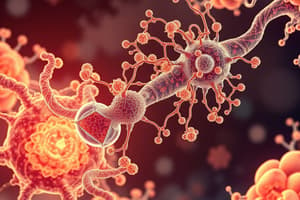Podcast
Questions and Answers
What leads to the decreased effectiveness of amphetamines with continuous use?
What leads to the decreased effectiveness of amphetamines with continuous use?
- Increased synthesis of neurotrophic factors
- Depletion of amine stores (correct)
- Altered gene expression in neurons
- Increased receptor sensitivity
Which mechanism is evident in alcohol tolerance due to chronic use?
Which mechanism is evident in alcohol tolerance due to chronic use?
- Decreased sensitivity of nerve receptors
- Inhibition of detoxification pathways
- Enhanced enzymatic breakdown of ethanol (correct)
- Increased production of ethanol
What physiological adaptation may reduce the effectiveness of diuretics like thiazides over time?
What physiological adaptation may reduce the effectiveness of diuretics like thiazides over time?
- Decreased cardiac output
- Reinforced action of the sympathetic nervous system
- Increased activity of the renin-angiotensin-aldosterone system (correct)
- Increased urine output
What is a potential consequence of the chronic use of nitroglycerin related to its metabolites?
What is a potential consequence of the chronic use of nitroglycerin related to its metabolites?
What consequence does the depletion of amine stores have on repeated use of amphetamines?
What consequence does the depletion of amine stores have on repeated use of amphetamines?
What is the term used for a rapid decrease in receptor response due to continuous agonist exposure?
What is the term used for a rapid decrease in receptor response due to continuous agonist exposure?
Which mechanism is primarily responsible for the downregulation of receptors following chronic agonist exposure?
Which mechanism is primarily responsible for the downregulation of receptors following chronic agonist exposure?
What happens to G-protein coupled receptors when exposed to high doses of epinephrine?
What happens to G-protein coupled receptors when exposed to high doses of epinephrine?
Which terminology describes the gradual decrease in the effect of a drug over days to weeks?
Which terminology describes the gradual decrease in the effect of a drug over days to weeks?
What role do arrestins play in the process of receptor desensitization?
What role do arrestins play in the process of receptor desensitization?
What effect does chronic exposure to agonists have on the synthesis of receptors?
What effect does chronic exposure to agonists have on the synthesis of receptors?
What is the consequence of receptor modification such as uncoupling during desensitization?
What is the consequence of receptor modification such as uncoupling during desensitization?
Chronic opioid use leads to which of the following receptor phenomena?
Chronic opioid use leads to which of the following receptor phenomena?
Study Notes
Receptor Desensitization and Tolerance
- Desensitization is rapid, occurring within minutes, while tolerance develops gradually over days to weeks.
- Mechanisms of desensitization and tolerance:
- Decreased receptor number:
- Downregulation: reduced synthesis of new receptors.
- Sequestration/internalization: receptors are endocytosed and degraded in lysosomes.
- Receptor modification:
- Uncoupling: receptors become unable to activate intracellular signaling pathways.
- Phosphorylation and arrestin binding: phosphorylation by GRKs, followed by arrestin binding, prevents receptor activation and promotes endocytosis.
- Exhaustion of intermediate messenger molecules:
- Continuous amphetamine use depletes amine stores in nerve terminals, reducing its effect.
- Increased metabolic breakdown:
- Chronic alcohol use increases ethanol breakdown by enzymes.
- Physiological adaptation:
- Thiazide diuretics' effectiveness decreases as the renin-angiotensin-aldosterone system compensates for blood pressure reduction.
- Decreased receptor number:
Example: Opioid Tolerance
- Chronic opioid use leads to downregulation of opioid receptors, requiring higher doses to achieve the same effect.
Example: Nitroglycerin Tolerance
- Tolerance results from decreased metabolism of nitroglycerin, leading to reduced levels of its active metabolite, nitric oxide, responsible for vasodilation.
Receptor Desensitization and Tolerance
- Desensitization is a rapid decrease in response to an agonist, occurring within minutes.
- Tolerance is a gradual decrease in response to an agonist, occurring over days or weeks.
- Mechanism of Desensitization and Tolerance:
- Decrease in Receptor Number:
- Downregulation: Reduced synthesis of new receptors.
- Sequestration/Internalization: Receptors are internalized and degraded by lysosomes.
- Receptor Modification:
- Uncoupling: Receptors become detached from their intracellular signaling pathway.
- Phosphorylation and Arrestin Binding: GPCRs are phosphorylated by GRKs, which attract arrestins. Arrestins prevent receptor activation and trigger endocytosis.
- Exhaustion of Secondary Messengers:
- Amine Depletion: Continuous amphetamine use depletes amine stores, reducing its effects.
- Increased Metabolic Breakdown:
- Alcohol Tolerance: Increased production of enzymes that break down ethanol.
- Nitrovasodilator Tolerance: Decreased metabolism of nitroglycerin, resulting in lower nitric oxide production.
- Physiological Adaptation:
- Diuretic Tolerance: Renin-angiotensin-aldosterone system increases activity to counteract the effects of thiazide diuretics.
- Decrease in Receptor Number:
Studying That Suits You
Use AI to generate personalized quizzes and flashcards to suit your learning preferences.




